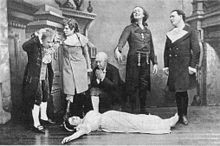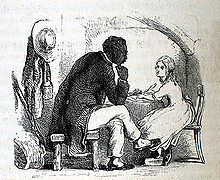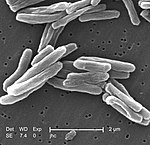Cultural depictions of tuberculosis
Through its effect on the world's population and major artists in various fields, tuberculosis has appeared in many forms in human culture. The disease was for centuries associated with poetic and artistic qualities in its sufferers, and was known as "the romantic disease".[2] Many artistic figures, including the poet John Keats, the composer Frédéric Chopin and the artist Edvard Munch
Tuberculosis has played prominent and recurring roles in diverse fields. These include
Context

Portrayals
Opera

Several major operas have exploited the theme of heroines dying tragically of tuberculosis, including Mimì in Puccini's opera La bohème.[8]
Theatre
A variety of plays have featured the theme of a character dying of tuberculosis. This includes Eugene O'Neill's Long Day's Journey into Night, where the protagonist, Edmund, is diagnosed with tuberculosis at the start of the play; his mental anguish forms a substantial part of the drama.[10]
Chopin and The Nightingale is a dramatic reading with music in six acts by Cecilia and Jens Jorgensen for narrator, two sopranos and piano. It enacts the true-life romance of the composer Frédéric Chopin, who had the disease, and "the Swedish nightingale"—the singer Jenny Lind.[a][3]
Novels

Nineteenth-century
The disease features, too, in a variety of English novels of the Victorian era, including Charles Dickens's 1848 Dombey and Son, Elizabeth Gaskell's 1855 North and South, and Mrs. Humphry Ward's 1900 Eleanor.[12][13]
When tuberculosis was essentially incurable, many patients stayed in a sanatorium for long periods. Several novels by different authors have been set in Swiss sanatoriums for tuberculosis sufferers, including Thomas Mann's The Magic Mountain,[14] A. E. Ellis's The Rack,[15] Liselotte Marshall's Tongue-Tied and Beatrice Harraden's Ships That Pass in the Night.[2] In addition, W. Somerset Maugham's 1938 short story "Sanatorium" was set in the north of Scotland (based on his own experience in a Scottish sanatorium in 1919)[5] Andrea Barrett's The Air We Breathe was set in upper New York State,[16] and Linda Grant's The Dark Circle was set in the Kent countryside.[17]
Victor Hugo used the tuberculosis theme repeatedly: the disease is the likely cause of the spinal deformity of the hunchback in his 1831 novel Notre-Dame de Paris, while Fantine becomes ill and ultimately dies from consumption in his 1862 Les Misérables.[8]

Many other novels have tuberculosis as a major plot element. For example,
The disease is not limited to human characters, but can help to achieve grim social realism in a novel. Upton Sinclair's novel The Jungle portrays tuberculosis as common among cattle reaching the meat-packing plants of Chicago. Sinclair wrote that "men welcomed tuberculosis in the cattle they were feeding, because it made them fatten more quickly".[20]
Some novels take a medical point of view on the disease, with doctors as major characters, and sometimes an intense use of medical language and procedure. For example, in
Nonfiction
Among the many nonfiction treatments of tuberculosis, Illness as Metaphor by Susan Sontag (1979) compares the metaphorical portrayal of the disease to cancer.[14] In his autobiography Angela's Ashes, Frank McCourt portrays the prevalence and impact of consumption during his childhood in Ireland.[23] In The Plague and I the author Betty MacDonald describes her nine months stay at a tuberculosis sanatorium and tuberculosis treatment in the pre-antibiotics era.[24]
Film

Many films have dramatised the effects of tuberculosis. In the 1936 film
Fine art

Several major artists have depicted tuberculosis from their personal experience. Rembrandt's wife Saskia seems to have died of the disease aged 29; he drew her both when sick and on her deathbed.[30] Edvard Munch returned to the theme many times in his career, including his paintings The Dead Mother and The Sick Child, of his mother and his sister Sophie, both of whom died of the disease.[31][32][30] Claude Monet's Camille Monet sur son lit de mort shows his first wife Camille on her deathbed.[30] Eugeen Van Mieghem's Facing Death depicts his wife Augustine lying sick with the disease.[30] Alice Neel's 1940 painting T.B. Harlem depicts a tuberculosis ward in New York.[7]
The permanent collection of the American Visionary Art Museum contains a life-size applewood sculpture, Recovery, of a tuberculosis sufferer with a sunken chest. It is the only known work by an anonymous patient in an English asylum who died of the disease in the 1950s.[33]
Music
A tuberculosis theme appears in
Anime and manga
Tuberculosis also appears in anime and manga.[36] For example, an early manga work by the influential author and illustrator Osamu Tezuka is named Tuberculosis. It tells the tale of a boy and his uncle who shrink to microscopic scale to fight the disease inside a child's body.[37]
Video games
Tuberculosis plays a major role in the 2018 western video game Red Dead Redemption 2. In the game, the protagonist Arthur Morgan contracts the disease after an altercation with a diseased farmer, giving him only a short time to live following his diagnosis. Faced with his own mortality, he becomes more conscious of his actions and tries to better himself in the time he has left, doing his best to give the remaining members of the Van der Linde gang an opportunity at a better life following his death, all the while seeking redemption for his past behaviour.[38][39]
See also
- List of tuberculosis victims
- Human interactions with microbes
- Illness as Metaphor
Notes
- ^ Her nickname alludes to Hans Christian Andersen's story "The Nightingale".[3]
References
- ^ S2CID 191371443.
- ^ ISBN 978-0-230-62574-7.
- ^ a b c "About Chopin's illness". Icons of Europe. Retrieved 11 June 2017.
- PMID 27993687.
- ^ ISBN 978-0-313-29916-2.
- ^ a b Wilsey, Ashley M. (May 2012). "'Half in Love with Easeful Death:' Tuberculosis in Literature". Humanities Capstone Projects (PhD Thesis), Pacific University. Archived from the original on 11 October 2017. Retrieved 9 June 2017.
- ^ a b "Tuberculosis (whole issue)". Journal of the American Medical Association. 293 (22): cover. 8 June 2005.
- ^ PMID 12463180.
- ^ "What's "Consumption," and Why Did It Kill Nicole Kidman?". Slate. 5 June 2001.
- JSTOR 29784382.
- ISBN 978-0-12-803708-9.
- ^ Lawlor, Clark. "Katherine Byrne, Tuberculosis and the Victorian Literary Imagination". British Society for Literature and Science. Retrieved 11 June 2017.
- ISBN 978-1-107-67280-2.
- ^ a b c d e f g "Pulmonary Tuberculosis/In Literature and Art". McMaster University History of Diseases. Retrieved 9 June 2017.
- ^ "The Rack by A. E. Ellis". Kirkus Reviews. Retrieved 12 June 2017.
- ^ Shriver, Lionel (15 March 2008). "A languorous novel of tuberculosis". The Daily Telegraph.
- ^ Hill, Susan (October 2016). "Cries and whispers in the TB sanitorium". The Spectator.
- PMC 2569739.
- ISBN 978-1-442-64493-9.
- ^ "Upton Sinclair Hits His Readers in the Stomach". History Matters. Retrieved 12 June 2017. Quote is from Chapter 9 of the novel.
- .
- ^ Dougary, Ginny (3 July 1999). "Books: The afterlife of a politician". The Independent.
- ISBN 978-0-8014-8928-0.
- ^ MacDonald, Betty. "The Plague and I". University of Washington Press. Retrieved 12 June 2017.
- ^ a b Corliss, Richard (22 December 2008). "Top 10 Worst Christmas Movies". Time.
'If you don't cry when Bing Crosby tells Ingrid Bergman she has tuberculosis', Joseph McBride wrote in 1973, 'I never want to meet you, and that's that.'
- ^ "Drunken Angel. Akira Kurosawa". Criterion. Retrieved 12 June 2017.
- ^ Edmundson-Cornell, Harry (9 March 2015). "Blind Swordfighting and Consumption: The Tale of Zatoichi". Sequart Organization. Retrieved 13 June 2017.
- ^ Kornberg, Jim (2 May 2008). "TB or Not TB? Did Val Kilmer portray the lunger Doc Holliday accurately in 1993's Tombstone?". Truewest Magazine. Archived from the original on 28 February 2018. Retrieved 12 June 2017.
- ^ "Heavenly Creatures Comprehensive Storyform". Dramatica. Retrieved 12 June 2017.
- ^ a b c d "Tuberculosis Throughout History: The Arts" (PDF). USAID. Archived from the original (PDF) on 30 June 2017. Retrieved 12 June 2017.
- ^ "The Sick Child". Works from the collection. The Munch Museum. Archived from the original on 3 October 2006. Retrieved 8 May 2006.
- ^ Bertman, Sandra L (19 November 2003). "Art Annotations: Munch, Edvard - The Sick Child". Literature, Arts, and Medicine Database. Archived from the original on 9 March 2005. Retrieved 8 May 2005.
- ^ "Recovery by Anonymous". American Visionary Art Museum. Archived from the original on 23 June 2017. Retrieved 12 June 2017.
- ISBN 978-91-7736-059-9.)
{{cite book}}: CS1 maint: multiple names: authors list (link - ^ Thomson, Graeme (1 June 2016). "Van Morrison – 10 of the best". The Guardian.
- ISBN 978-1-880656-96-9.
Kekkaku (Tuberculosis) This disease also existed in Japan and, while it does not show up much in stories set in a contemporary setting, it does appear in anime and manga set in earlier times... In Samurai X: Trust and Betrayal two historical personages, Okita Soji and Takasugi, have TB ... The eighth story in Lone Wolf and Cub includes Izawa, a samurai suffering from TB.
- ^ "Osamu Tezuka, God of Manga". Legacy.com. 2011.
- ^ Davidson, Tom (13 November 2018). "Red Dead Redemption 2 players are frantically searching for a tuberculosis cure". Daily Mirror. Retrieved 5 March 2019.
- ^ Gumeny, Eirik (12 March 2019). "What Red Dead Redemption 2 gets right about having a terminal disease". Polygon. Retrieved 5 May 2019.


